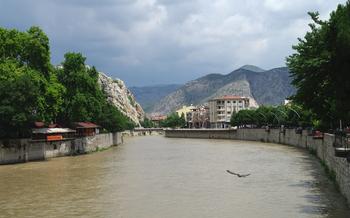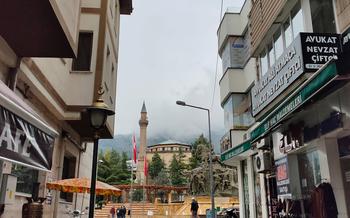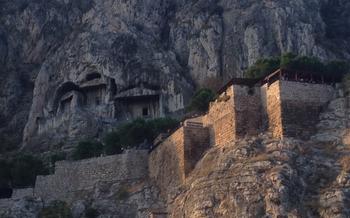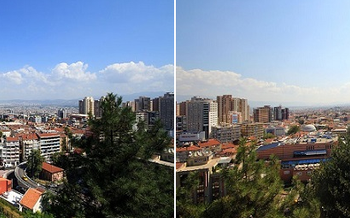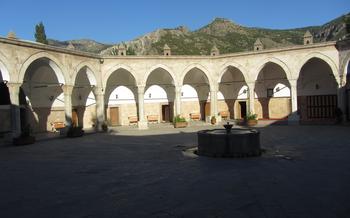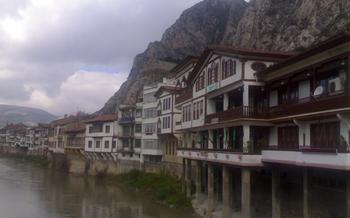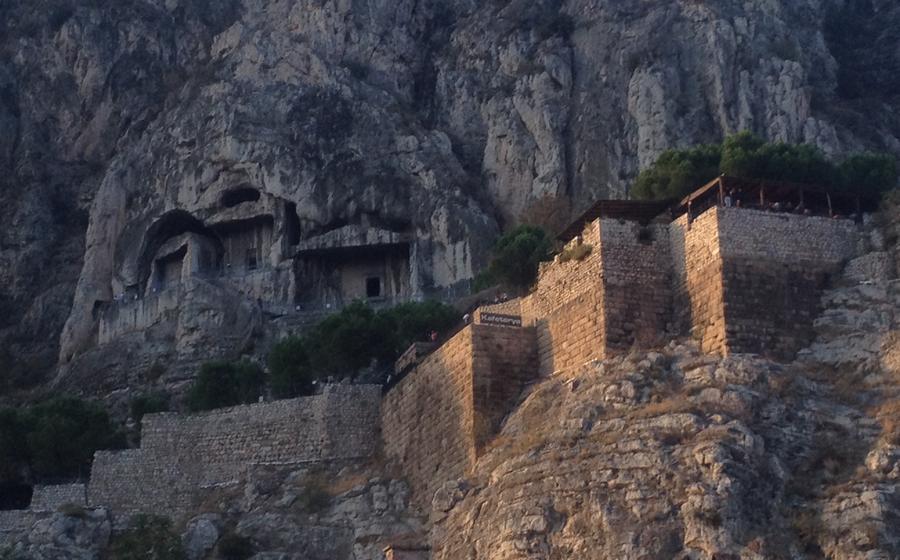
Sultan II. Beyazıd Mosque & Külliye
- Unveiling the Architectural Masterpiece: Sultan II. Beyazıd Mosque
- The Alluring Külliye: A Complex of Architectural Wonders
- The Theological School: A Center of Knowledge
- The Library: A Repository of Knowledge
- The Hospital: A Haven of Healing
- The Caravanserai: A Resting Place for Travelers
- The Hamam: A Place of Purification and Relaxation
- Exploring the Historic City Center
- The Grand Mosque of Amasya: A Symbol of Faith
- The Historic Mansions of Amasya: Echoes of the Past
- Insider Tip: Unveiling Hidden Gems
Unveiling the Architectural Masterpiece: Sultan II. Beyazıd Mosque
The Sultan II. Beyazıd Mosque, also known as the Great Mosque of Amasya, stands as a testament to the architectural prowess of the Ottoman Empire. Built in the 15th century, the mosque boasts a rich history, having served as a place of worship, a center of Islamic learning, and a symbol of the city's cultural heritage. Its impressive architecture features intricate tilework, elegant domes, and soaring minarets, creating a harmonious blend of aesthetics and spirituality. The interior of the mosque is equally captivating, with a vibrant prayer hall adorned with colorful tiles, an ornate mihrab, and a beautifully carved minbar. Visiting hours for the mosque are typically from sunrise to sunset, and visitors are advised to dress respectfully, covering their shoulders and knees. By observing these guidelines, visitors can immerse themselves in the tranquility of this sacred space and appreciate its architectural grandeur.
The Alluring Külliye: A Complex of Architectural Wonders
In the heart of Amasya, nestled amidst the vibrant city, lies the awe-inspiring Amasya Külliye, a magnificent complex that embodies the essence of Islamic architecture. A külliye, a concept unique to Islamic civilization, is a complex of religious and social buildings that serves as a center for intellectual, spiritual, and communal life. The Amasya Külliye, established during the reign of the Ottoman Sultan II. Beyazıd, stands as a testament to the enduring legacy of Islamic architecture and its profound impact on the city's cultural landscape.
The külliye comprises a harmonious ensemble of structures, each serving a distinct purpose. Beyond the Sultan II. Beyazıt Mosque, the complex encompasses a theological school, a library, a hospital, an imaret (soup kitchen), a caravanserai (inn), a hamam (bathhouse), and a bazaar, forming a microcosm of Ottoman society. The külliye's architectural style seamlessly blends Ottoman and Seljuk influences, creating a cohesive and visually stunning masterpiece.
Exploring the külliye is akin to embarking on a journey through time. Visitors can wander through the serene courtyards, admire the intricate tilework and elegant arches, and experience the palpable sense of history that permeates the air. The külliye stands as a testament to the vision and artistry of its creators, a testament to the enduring power of faith and community in shaping the urban fabric of the Ottoman Empire.
The Theological School: A Center of Knowledge
Established as an integral part of the Sultan II. Beyazıd Külliye, the theological school served as a beacon of Islamic learning and scholarship in Amasya. Dedicated to nurturing the minds of aspiring scholars, it offered a comprehensive curriculum encompassing theology, law, philosophy, and other Islamic sciences. Renowned for its erudite faculty and rigorous teaching methods, the school attracted students from across the region, eager to delve into the depths of Islamic knowledge.
Among the notable scholars who graced the halls of the theological school were Qadizade-i Rumi, a renowned jurist and theologian whose teachings on Islamic law and ethics continue to influence Islamic thought to this day. His profound insights into the complexities of Islamic jurisprudence earned him a distinguished reputation, attracting students from far and wide who sought to learn from his wisdom.
The legacy of the theological school extends beyond the confines of its classrooms. Its alumni went on to hold prominent positions as judges, administrators, and religious leaders, contributing significantly to the intellectual and spiritual development of the Ottoman Empire. Their contributions to Islamic scholarship and governance left an indelible mark on the history of the region, shaping the religious and cultural landscape for generations to come.
The Library: A Repository of Knowledge
The library within the Amasya Külliye stands as a testament to the importance placed on education and scholarship during the Ottoman era. Housing a vast collection of books and manuscripts, the library served as a repository of knowledge, encompassing various subjects such as religion, science, literature, and history. Its collection was meticulously curated, with books carefully selected and cataloged to ensure the preservation and dissemination of knowledge.
The architectural design of the library reflects the reverence accorded to knowledge. With its domed roof symbolizing the heavens and its intricate carvings and stained-glass windows depicting scenes of learning, the library created an inspiring environment for scholars and students alike. The library's collection was not merely a passive repository but an active source of knowledge, with scholars engaging in lively debates and discussions, exchanging ideas, and contributing to the advancement of various fields of study.
Preservation efforts have been meticulously undertaken to ensure that the library's collection remains accessible to future generations. Rare manuscripts have been restored, digitized, and cataloged, making them available to researchers and scholars worldwide. The library's legacy extends beyond its physical walls, as it has inspired the establishment of modern libraries and educational institutions throughout the region, continuing the tradition of fostering knowledge and intellectual pursuit.
The Hospital: A Haven of Healing
The hospital within the Amasya külliye played a crucial role in providing medical care to the community during the Ottoman era. It offered a wide range of services, including treatment for various ailments, surgery, and pharmacology. The hospital's architectural design reflected its dedication to patient care, featuring spacious wards, gardens for convalescence, and dedicated spaces for teaching and research. Its legacy and impact on healthcare in the region are still felt today, as it contributed to the advancement of medical knowledge and practices.
The Caravanserai: A Resting Place for Travelers
Within the Amasya Külliye, travelers weary from their journeys found solace and respite at the caravanserai, a traditional roadside inn. This architectural gem, with its fortified walls, offered a safe haven for merchants, pilgrims, and adventurers alike. Step inside the caravanserai's courtyard, and you'll be transported back in time, surrounded by the echoes of countless stories shared over centuries. Explore the stables where animals were tended to, the guest rooms that provided weary travelers with a place to rest, and the communal spaces where people from diverse backgrounds exchanged tales and news from distant lands. The caravanserai stands as a testament to the importance of hospitality and the role it played in facilitating trade and cultural exchange along the Silk Road.
The Hamam: A Place of Purification and Relaxation
Function and purpose
In the heart of Amasya, nestled amidst the historic streets, lies the hamam, a traditional Turkish bathhouse that has stood the test of time. Serving as a sanctuary of purification and relaxation for centuries, the hamam holds a significant place in Islamic culture, offering a unique blend of physical and spiritual rejuvenation.
Rituals and customs
Stepping into the hamam is a ritual steeped in tradition. Visitors are first greeted by a warm and humid atmosphere, enveloping them in a sense of tranquility. They then proceed to disrobe and wrap themselves in peshtemals, traditional Turkish towels, before entering the bathing area.
Inside, a series of heated chambers awaits, each gradually increasing in temperature. Bathers move from one chamber to the next, allowing their bodies to acclimate to the rising heat. The process of cleansing begins with a thorough wash using kese, a rough mitt, which helps exfoliate the skin and remove impurities.
Architectural features
The hamam's architectural design is a testament to its purpose. The domed roof, a defining feature of Islamic architecture, allows steam to circulate freely, creating a humid environment that enhances the bathing experience. The marble floors, smooth and cool to the touch, provide a contrast to the warmth of the air.
Visiting the hamam
For those seeking an authentic Turkish bathing experience, visiting a hamam is a must. It is advisable to book an appointment in advance to avoid disappointment. Upon arrival, visitors are provided with fresh towels and slippers, ensuring their comfort and hygiene.
Before entering the bathing area, it is customary to rinse off under a cold shower to prepare the body for the heat. Once inside, bathers can relax and enjoy the soothing steam, allowing their muscles to unwind and their minds to drift into a state of tranquility.
After cleansing and exfoliating, bathers can indulge in a massage, a traditional component of the hamam experience. Skilled masseurs use a variety of techniques to release tension, promote circulation, and leave visitors feeling refreshed and invigorated.
A visit to the hamam is not just about physical cleansing but also about embracing a cultural tradition that has been cherished for centuries. It is an opportunity to immerse oneself in the local way of life and experience firsthand the essence of Turkish hospitality.
Exploring the Historic City Center
Strolling through the historic city center of Amasya is like stepping back in time. Admire the architectural wonders of the Amasya Castle, the Grand Mosque, and the numerous historic mansions that line the cobblestone streets. Take a leisurely walk across the scenic bridges spanning the Yesilırmak River, offering breathtaking views of the city and its surroundings. Immerse yourself in the local culture by visiting traditional markets, savoring delicious cuisine at family-run restaurants, and sipping Turkish coffee in charming teahouses. Don't miss the opportunity to explore the city's vibrant nightlife, with a variety of bars, cafes, and traditional music venues to choose from. Amasya truly comes alive after sunset, offering a unique and unforgettable experience.
The Grand Mosque of Amasya: A Symbol of Faith
The Grand Mosque of Amasya stands as a testament to the city's rich Islamic heritage, blending Seljuk and Ottoman architectural influences to create a masterpiece of religious architecture. Its imposing facade, adorned with intricate carvings and calligraphy, invites visitors to step into a realm of spiritual tranquility. Inside, the mosque's vast prayer hall is a symphony of light and color, with stunning tilework adorning the walls and a magnificent mihrab that serves as the focal point for worshipers. The Grand Mosque remains a vibrant center of Islamic faith, where locals and visitors alike gather to pray, study, and reflect on the divine.
The Historic Mansions of Amasya: Echoes of the Past
Amasya's historic mansions, with their intricate facades, elegant balconies, and beautifully carved wooden doors, are a testament to the city's rich history and architectural heritage. These grand structures, built by wealthy merchants, notables, and government officials, showcase a blend of Ottoman and Seljuk architectural styles, each with its own unique charm and character.
Some of the most notable mansions include the Hazeranlar Mansion, with its stunning courtyard and ornate tilework, the Tokatlıoğlu Mansion, famous for its intricate wooden carvings, and the Çelebi Mansion, which houses a museum dedicated to Amasya's history and culture.
While some of these mansions are privately owned, others have been converted into museums, hotels, and restaurants, offering visitors a chance to experience the grandeur of these historic buildings firsthand. Strolling through the narrow streets of Amasya's old town, visitors can admire the intricate details of these architectural gems and imagine the stories of the people who once lived within their walls.
Insider Tip: Unveiling Hidden Gems
Beyond the main tourist attractions, Amasya offers a wealth of hidden gems waiting to be discovered. Venture off the beaten path to uncover local markets brimming with fresh produce, spices, and handmade crafts. Immerse yourself in the local culture by attending traditional festivals showcasing music, dance, and culinary delights. Learn the art of traditional crafts such as pottery, carpet weaving, or copperware making, and take home a unique souvenir.
Don't miss the picturesque viewpoints that offer breathtaking panoramas of the city, the winding river, and the lush green valleys. For the best photography opportunities, capture the city bathed in the golden hues of sunrise or sunset, or take advantage of the clear night skies for some stargazing and astrophotography.
To truly delve into the hidden treasures of Amasya, consider hiring a local guide. These knowledgeable individuals can lead you to secret spots, share fascinating stories about the city's past, and provide insights into the local way of life. Embrace the opportunity to connect with the friendly locals, savor the authentic flavors of Amasya's cuisine, and create lasting memories that will make your trip truly unforgettable.

